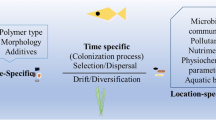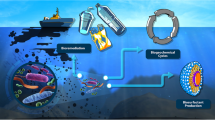Abstract
Polybrominated diphenyl ethers (PBDEs) are persistent organic pollutants and have therefore drawn much environmental concern. We aimed to compare aerobic degradation of different PBDE congeners under various treatments and reveal the bacterial community associated with PBDE degradation in sediment. Results of this study indicate that degradation rates of BDE-15 were enhanced 45.1 and 81.3 % with the addition of suspended and microencapsulated Pseudomonas sp., respectively. However, the degradation rates of BDE-28, BDE-47, BDE-99, and BDE-100 did not differ among experimental treatments. Degradation rates of PBDE congeners were in the order of BDE-15 > BDE-28 > BDE-47 > BDE-99 > BDE-100. Using a pyrosequencing-based metagenomic approach, we found that addition of various treatments altered the microbial community composition in the sediment. Twenty-four bacterial genera associated with degradation of PBDEs; six are the core bacterial genera common among PBDE degraders. The diverse bacterial composition among different PBDE congener degradation indicates different combinations of bacteria involved in degradation of different PBDE congeners.





Similar content being viewed by others
References
Chang BV, Yuan SY, Ren YL (2012) Aerobic degradation of tetrabromobisphenol-A by microbes in river sediment. Chemosphere 87:535–541
Claesson MJ, Wang Q, O’Sullivan O, Greene-Diniz R, Cole JR, Ross RP, Toole PWO (2010) Comparison of two next-generation sequencing technologies for resolving highly complex microbiota composition using tandem variable 16S rRNA gene regions. Nucleic Acids Res 38:e200
Cole JR, Wang Q, Cardenas E, Fish J, Chai B, Farris RJ, Kulam-Syed-Mohideen AS, McGarrell DM, Marsh T, Garrity GM, Tiedje JM (2009) The ribosomal database project: improved alignments and new tools for rRNA analysis. Nucleic Acids Res 37:D141–D145
Edgar RC, Haas BJ, Clemente JC, Quince C, Knight R (2011) UCHIME improves sensitivity and speed of chimera detection. Bioinformatics 27:2194–2200
Hites RA (2004) Polybrominated diphenyl ethers in the environment and in people: a meta-analysis of concentrations. Environ Sci Technol 38:945–956
Hsu FY, Wang ZY, Chang BV (2013) Use of microcapsules with electrostatically immobilized bacterial cells or enzyme extract to remove nonylphenol in wastewater sludge. Chemosphere 91:745–750
Huang HW, Chang BV, Cheng CH (2012) Biodegradation of dibromodiphenyl ether in river sediment. Int Biodeterior Biodegrad 68:1–6
Huang HW, Chang BV, Lee CC (2014) Reductive debromination of decabromodiphenyl ether by anaerobic microbes from river sediment. Int Biodeterior Biodegrad 87:60–65
Kim S, Bae W, Hwang J, Park J (2010) Aerobic TCE degradation by encapsulated toluene-oxidizing bacteria, Pseudomonas putida and Bacillus spp. Water Sci Technol 62:1991–1997
Lee LK, He J (2010) Reductive debromination of polybrominated diphenyl ethers by anaerobic bacteria from soils and sediments. Appl Environ Microbiol 76:794–802
Liu L, Zhu W, Xiao L, Yang L (2011) Effect of decabromodiphenyl ether (BDE-209) and dibromodiphenyl ether (BDE-15) on soil microbial activity and bacterial community composition. J Hazard Mater 186:883–890
Oros DR, Hoover D, Rodigari F, Crane D, Sericano J (2005) Levels and distribution of polybrominated diphenyl ethers in water, surface sediments, and bivalves from the San Francisco Estuary. Environ Sci Technol 39:33–41
Qi WT, Ma J, Yu WT, Xie YB, Wang W, Ma XJ (2006) Behavior of microbial growth and metabolism in alginate–chitosan–alginate (ACA) microcapsules. Enzyme Microb Technol 38:697–704
Robrock KR, Coelhan M, Sedlak DL, Alvarez-Cohent L (2009) Aerobic biotransformation of polybrominated diphenyl ethers (PBDEs) by bacterial isolates. Environ Sci Technol 43:5705–5711
Robrock KR, Mohn WW, Eltis LD, Alvarez-Cohen L (2011) Biphenyl and ethylbenzene dioxygenases of Rhodococcus jostii RHA1 transform PBDEs. Biotechnol Bioeng 108:313–321
Shi G, Yin H, Ye J, Peng H, Li J, Luo C (2013a) Effect of cadmium ion on biodegradation of decabromodiphenyl ether (PBDE-209) by Pseudomonas aeruginosa. J Hazard Mater 263:711–717
Shi G, Yin H, Ye J, Peng H, Li J, Luo C (2013b) Aerobic biotransformation of decabromodiphenyl ether (PBDE-209) by Pseudomonas aeruginosa. Chemosphere 93:1487–1493
Tokarz JA, Ahn MY, Leng J, Filley TR, Nies L (2008) Reductive debromination of polybrominated diphenyl ethers in anaerobic sediment and a biomimetic system. Environ Sci Technol 42:1157–1164
Uhnakova B, Petrickova A, Biedermann D, Homolka L, Vejvoda V, Bednar P, Papouskova B, Sulc M, Martínkova L (2009) Biodegradation of brominated aromatics by cultures and laccase of Trametes versicolor. Chemosphere 76:826–832
Watanabe I, Sakai S (2003) Environmental release and behavior of brominated flame retardants. Environ Int 29:665–682
Xin J, Liu X, Liu W, Zheng X (2014) Effects of biochar-BDE-47 interactions on BDE-47 bioaccessibility and biodegradation by Pseudomonas putida TZ-1. Ecotoxicol Environ Saf 106:27–32
Xu M, Chen X, Qiu M, Zeng X, Xu J, Deng D, Sun G, Li X, Guo J (2012) Bar-coded pyrosequencing reveals the responses of PBDE-degrading microbial communities to electron donor amendments. PLoS One 7:e30439
Yu KSH, Wong AHY, Yau KWY, Wong YS, Tam NFY (2005) Natural attenuation, biostimulation and bioaugmentation on biodegradation of polycyclic aromatic hydrocarbons (PAHs) in mangrove sediments. Mar Pollut Bull 51:1071–1077
Zhang W, Zhang M, An S, Xiong B, Li H, Cui C, Lin K (2012) Ecotoxicological effects of decabromodiphenyl ether and cadmium contamination on soil microbes and enzymes. Ecotoxicol Environ Saf 82:71–79
Acknowledgments
This research was supported by the National Science Council, Republic of China (NSC100-2632-B-031-001-MY3).
Conflicts of interest
All contributing authors declare no conflicts of interest.
Author information
Authors and Affiliations
Corresponding author
Additional information
Responsible editor: Philippe Garrigues
Rights and permissions
About this article
Cite this article
Yang, CW., Huang, HW., Chao, WL. et al. Bacterial communities associated with aerobic degradation of polybrominated diphenyl ethers from river sediments. Environ Sci Pollut Res 22, 3810–3819 (2015). https://doi.org/10.1007/s11356-014-3626-9
Received:
Accepted:
Published:
Issue Date:
DOI: https://doi.org/10.1007/s11356-014-3626-9




